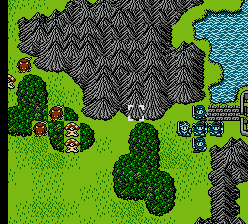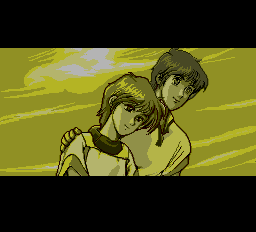Just Breed (ジャストブリード)
Release Date: 12/15/1992
System: Famicom
Developer: Random House
Publisher: Enix
This is the last Famicom game on my list. It came out around the same time as Dragon Quest V and Final Fantasy V, so it didn’t get as much respect as it deserved at the time it came out. Apparently it was in development hell for a long time, but it ends up looking and sounding much better than most Famicom games. It’s one of the largest Famicom games (only Metal Slader Glory and Kirby’s Adventure equal it, among licensed games). It even uses some kanji in the text, which Super Famicom games were not doing at this point.
There is a fan translation so I won’t be as detailed in covering the plot as I have been on some other games that have no translations.
The backstory is basically that there were seven kingdoms associated with seven gemstones, but they were all destroyed at once for an unknown reason. There’s a prophecy that when the seven gemstones are reunited, the followers of righteousness (the “just breed”) can defeat the evil again. At the beginning of the game, the main character (a captain of a guard unit) has his girlfriend captured, who was the Priestess of Sapphire. He takes her tiara and then goes out to find her.
The character and monster designs were done by Takada Yuzo, best known for the manga 3×3 Eyes.
Like Shining Force, this game mixes RPG town exploration with outdoor battles. The graphics are similar to Dragon Quest.
 |
| Feris captured |
When you leave the first town, the first battle begins. The game doesn’t really have numbered battles, but for convenience I’ll just number the fights I had.
Battle 1
This is an easy stage to begin with. The game works based on squads. You pick the leader (Kurisu in this case) and then can move and attack with all the units under the leader. I have two bowmen and two fighters who can use swords and spears. A nice feature is that XP is shared among the entire squad, so there’s no need to distribute kills.
The battles end when you either clear out all the enemies (getting a victory screen), in which case you can explore the map freely.
Otherwise, the battle ends when someone moves into a town or house. Even if you “complete” a battle, the monsters will respawn if you leave the town or house. There are items and spells that can warp you to locations, though.
After the first battle, Kurisu’s squad gains a magician. Kurisu himself can cast some spells — just heal at the beginning, but that’s a big help.
Battle 2
The frogs on this map can spit to hit us at a distance. This stage also introduces monster lairs (the circle at the bottom left). They generate monsters throughout the battle. If you can get a person next to the lair they can destroy the lair, but no one can go across the river here. Killing all the enemies also ends the battle and stops the generation.
Battle 3
This is the first battle that actually presents a challenge. In addition to the frogs, there are snails that tank, crab-like things that cast spells, and more inaccessible monster lairs. The new magician’s spells help a lot, as does buying a bunch of Herbs for healing.
Battle 4
More new enemies — Skeletons. They also have large HPs. I also got a new cleric who is her own squad, but later she is joined by Rolan and his troops to make my second real squad! This is sort of a two-part battle since first you head to the top right to get Karen (the cleric) and then leave and go down to the bottom right to the next town.
This is a pretty good game so far; we’ll see if it maintains its quality throughout the game.















































